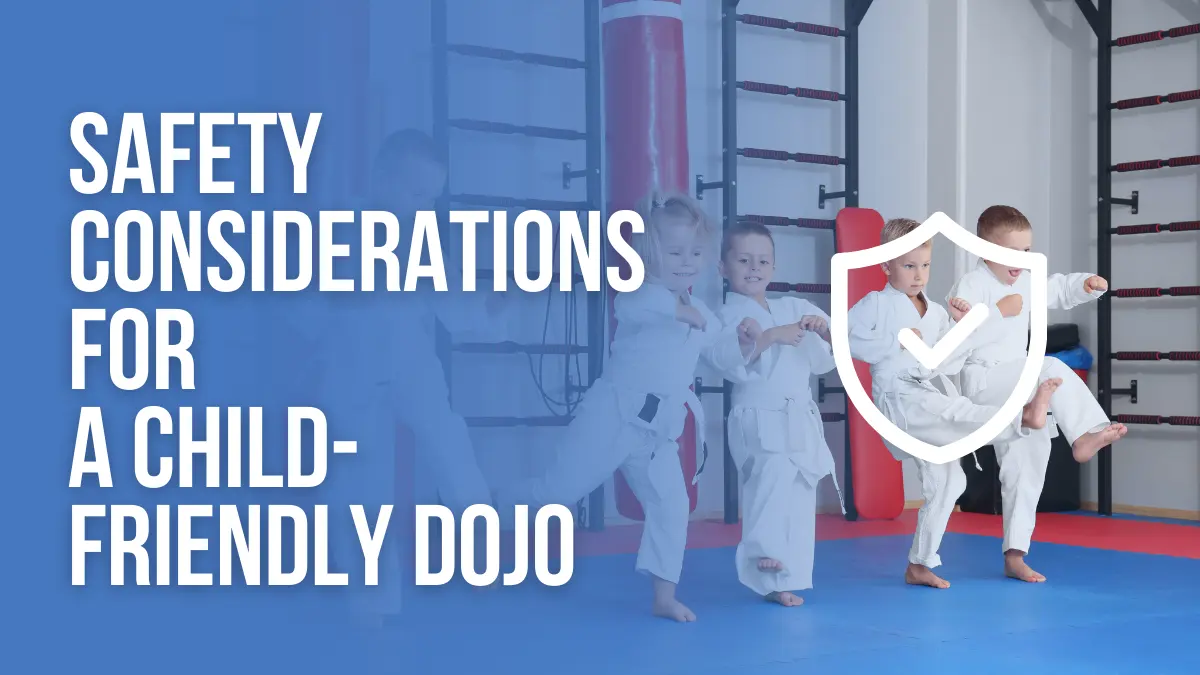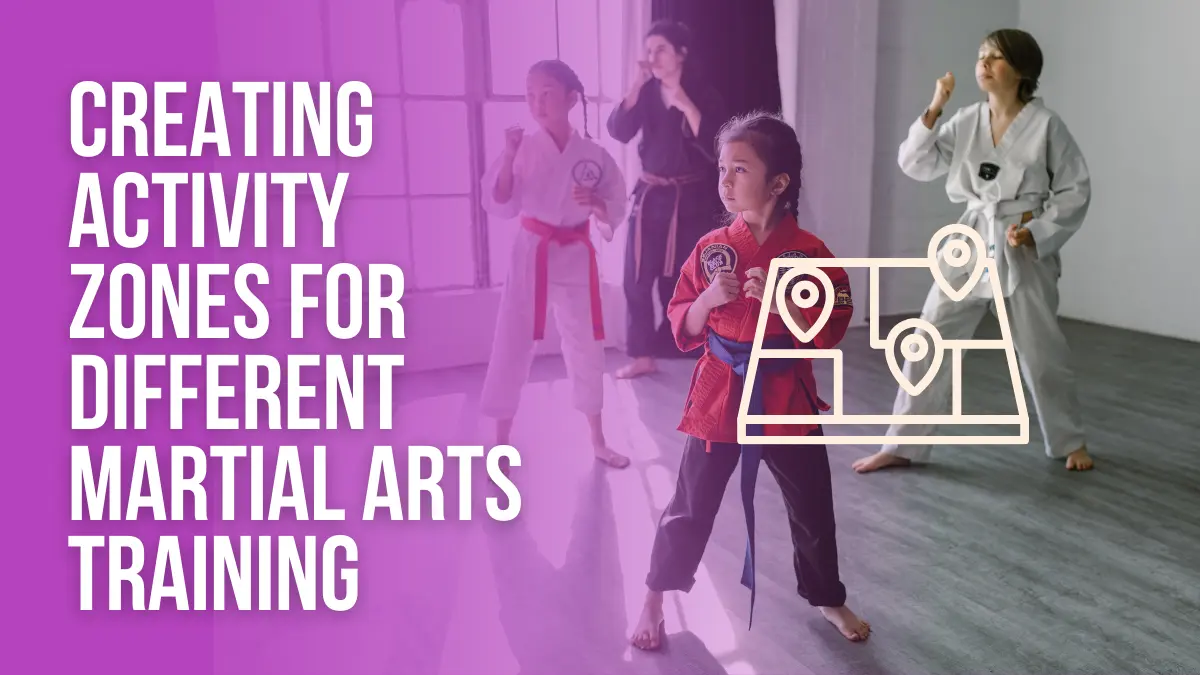Karate dojo design is essential for creating a functional and inviting space, especially catering to children. A kid-friendly dojo should blend creativity and practicality, offering an environment where young learners feel comfortable and motivated.
From playful color schemes to safety-focused layouts, the right design can foster a welcoming atmosphere while supporting skill development. In this guide, we’ll explore 20 creative karate dojo design ideas that strike the perfect balance between discipline and fun, making your dojo an ideal place for young martial artists to thrive.
1. Optimizing Dojo Interior Design for Kid-Friendly Spaces
When optimizing dojo interior design for kid-friendly spaces, the focus should be safety, functionality, and an engaging atmosphere. Durable, non-slip flooring ensures safety while maintaining ease of cleaning, and cushioned mats offer comfort and protection during training.
Here are key elements to include:
- Non-slip, cushioned mats for safe training
- Soft, welcoming colors that energize without overwhelming
- Modular equipment for flexibility and easy storage
- Kid-accessible storage for independence and organization
Finally, a clear, open layout with designated areas for different activities helps maintain structure while keeping the dojo functional and enjoyable for young learners.
2. Innovative Dojo Design Ideas to Inspire Young Students
A dojo designed with creativity can inspire young students to engage deeply with martial arts. Incorporating motivational and interactive elements will enhance both their learning and enjoyment.
- Vibrant murals: These can feature martial arts heroes or action scenes to spark students’ imagination and excitement.
- Interactive training stations: offer hands-on challenges to make learning more dynamic and engaging.
- Motivational quotes: prominently displayed to foster focus, discipline, and perseverance in young learners.
These design ideas help create a dojo environment that motivates and excites young students.
3. Creating a Safe and Fun Home Dojo Design for Kids
Designing a home dojo for kids requires balancing safety and engagement. With the right elements, you can create a fun, functional space that encourages consistent practice.
- Cushioned mats: These provide a soft, protective surface to prevent injuries during practice.
- Compact training equipment: To maximize smaller areas, Choose space-saving items like foldable mats and portable punching bags.
- Vibrant decor: Use colorful designs or martial arts-themed posters to keep the space lively and exciting for kids.
By combining safety and creativity, your home dojo can be where kids enjoy training while staying protected.
4. Incorporating Traditional and Modern Elements
Blending traditional and modern design elements can create a dojo space that respects martial arts heritage while embracing contemporary features. This balanced approach offers a unique atmosphere for students of all ages.
- Traditional decor pieces: Display items like martial arts scrolls, wooden weapons, or calligraphy to honor the dojo’s roots.
- Modern lighting solutions: Use LED lighting and energy-efficient fixtures for a clean and updated look.
- Contemporary equipment: Introduce adjustable training tools and technology to enhance practice sessions.
Combining these elements ensures a dojo that feels classic and current, appealing to students of diverse backgrounds.
5. Maximizing Space in Small Dojos
Designing a small dojo can be challenging, but you can create an effective training space with strategic planning. Consider multifunctional elements and clever layouts to optimize every square foot.
- Foldable equipment: Use foldable mats and portable training tools that can be easily kept when not in use.
- Wall-mounted storage: Install hooks, racks, and shelves to keep equipment off the floor and maintain a clutter-free environment.
- Mirrors for depth: Place mirrors strategically to create the illusion of a larger space.
These solutions make even a compact dojo feel spacious and fully equipped.
6. Safety Considerations for a Child-Friendly Dojo

Safety must be the top priority when designing a dojo for children. Implementing key safety features can ensure that young students train confidently without risk of injury.
- Padded flooring: Use cushioned mats throughout the training area to minimize impact and prevent slips.
- Rounded edges: Choose furniture and equipment with rounded edges to lower the risk of bumps and bruises.
- Secure equipment setup: Anchor all heavy items to prevent tipping or falling during vigorous activities.
With these safety measures, your dojo will be a secure and supportive environment for young martial artists.
7. Encouraging Creativity with Customizable Spaces
Customizable spaces can empower young students to feel more engaged and connected to the dojo. You can create a training environment that adapts to their needs and preferences by offering flexible design options.
- Modular furniture: Use furniture that can be rearranged or reconfigured to support different activities.
- Personalized storage areas: Allow students to label and decorate their storage spaces to give them a sense of ownership.
- Interactive wall sections: Include whiteboards or corkboards where students can display drawings or share their thoughts.
These customizable elements encourage creativity and make the dojo feel like a shared space for growth and self-expression.
8. Using Technology to Enhance the Learning Environment
Integrating technology into the dojo can make training more engaging and effective for young students. With the right tools, you can create an interactive learning experience that complements traditional training methods.
- Interactive screens: Use screens to display instructional videos, live demonstrations, or progress tracking.
- Digital scoring systems: Implement electronic scoring for sparring sessions to provide real-time feedback.
- Virtual classes: Offer online training options or hybrid classes for students who can’t attend in person.
These technological additions can enhance learning, making martial arts training more dynamic and accessible.
9. Designing Communal Spaces for Parents and Students
Creating communal spaces in the dojo fosters a sense of community and connection between students, parents, and instructors. These areas should be welcoming and comfortable for everyone.
- Comfortable seating areas: Provide sofas, benches, or lounge chairs where parents can relax while watching their children train.
- Informational bulletin boards: Display class schedules, upcoming events, and student achievements to keep parents engaged.
- Kid-friendly play areas: Set up small play zones with toys and books for younger siblings to enjoy.
These shared spaces help strengthen relationships and build a supportive dojo community.
10. Integrating Nature: Bringing the Outdoors Indoors
Incorporating elements of nature into your dojo can create a calming and refreshing environment. Natural features help balance energy and provide a welcoming atmosphere for students and parents alike.
- Indoor plants: Place potted plants or hanging greenery to bring a sense of tranquility and fresh air.
- Natural lighting: Use large windows or skylights to maximize sunlight and reduce artificial lighting.
- Wooden accents: Include wooden furniture or decor to add warmth and an organic feel to the space.
These nature-inspired elements can make the dojo more inviting and boost overall well-being.
11. Multi-Purpose Mats: Versatile Solutions for Training
Multi-purpose mats are essential in any dojo, offering flexibility and functionality for various training exercises. These mats adapt to different activities, making them a valuable addition to any martial arts space.
- Easily adjustable layouts: Mats can be arranged for stretching, sparring, or group activities, ensuring diverse use.
- Impact absorption: Thick padding helps cushion falls and prevents injuries during intense training sessions.
- Easy storage: Mats can be folded or rolled for convenient storage when not in use.
These versatile mats support a safe and adaptable training environment for students of all ages.
12. Incorporating Efficient Storage Solutions
Practical storage solutions are critical to maintaining an organized and clutter-free dojo. Strategic storage options can maximize space and keep training areas tidy.
- Wall-mounted racks: Use hooks and shelves to store equipment like gloves, pads, and weapons off the floor.
- Cubby systems: Install cubbies or lockers where students can neatly store their items and gear.
- Rolling storage bins: Opt for bins on wheels for easy mobility and accessibility during training sessions.
With these solutions, your dojo will stay organized, providing a more focused environment for practice.
13. Color Psychology: Using Colors to Motivate and Energize Kids

Using the right colors in a dojo can significantly influence a child’s mood and energy. Color psychology helps create an environment that is stimulating and conducive to learning.
Warm colors (reds and oranges): These colors can promote energy and excitement, making them great for active training areas.
Cool colors (blues and greens): Use these shades to create a calming atmosphere in areas designated for relaxation or focus.
Neutral tones: Soft neutrals like beige and light gray provide balance and prevent overstimulation.
Strategically using these colors can help set the right tone for different training zones within the dojo.
14. Creating Play Zones for Younger Siblings
A designated play zone for younger siblings can keep them entertained while their older siblings train. This area should be safe, engaging, and easily monitored by parents.
- Soft play mats: Use cushioned mats for a safe and comfortable play surface.
- Age-appropriate toys: Include books, puzzles, and toys suitable for younger children to keep them occupied.
- Visual boundaries: Use partitions or rugs to define and separate the play area from the training zones.
Creating these play zones ensures that the dojo remains a welcoming space for the whole family.
15. Lighting Solutions for a Bright and Inviting Dojo
Proper lighting is vital for creating a welcoming and safe dojo environment. Combining natural and artificial lighting can optimize visibility and enhance the overall atmosphere.
- Natural light: Use large windows or skylights to let in sunlight, making a bright and airy space.
- LED overhead lights: Opt for energy-efficient LED lighting to ensure even illumination without harsh glare.
- Accent lighting: Use adjustable spotlights to highlight specific areas, such as training zones or entrances.
Adequate lighting enhances focus, safety, and the overall training experience.
16. Choosing the Right Kid-Friendly Furniture for the Dojo
Selecting appropriate furniture for a kid-friendly dojo is essential for ensuring comfort, safety, and functionality. The right choices can create a welcoming and practical environment for young martial artists.
- Soft seating options: Use padded benches or bean bags that are comfortable and safe for children to sit on.
- Sturdy, rounded-edge tables: Choose tables with rounded edges to prevent injuries and ensure durability.
- Low-height shelves: Install shelves that are accessible for kids, allowing them to store and retrieve items independently.
With the right furniture, your dojo will feel both inviting and child-friendly.
17. Creating Activity Zones for Different Martial Arts Training

Dividing your dojo into distinct activity zones can improve training efficiency and help students focus on specific skills. Designating separate areas allows you to cater to different martial arts techniques and training exercises.
- Warm-up and stretching area: Set up a space with mats for stretching and flexibility exercises before training begins.
- Sparring and technique zone: Use padded flooring and open space to practice sparring, drills, and kata.
- Focus zone for meditation: Design a quiet corner with minimal distractions for meditation and breathing exercises.
With these activity zones, your dojo will be organized and conducive to effective martial arts training.
18. Eco-Friendly Dojo Design: Using Sustainable Materials
Designing an eco-friendly dojo benefits the environment and promotes a sense of responsibility and mindfulness among students. By choosing such materials, you can create a healthier training space.
- Bamboo flooring: Use bamboo instead of hardwood for a renewable and durable option.
- Low-VOC paints: Opt for low or zero-VOC paints to lower harmful emissions and improve indoor air quality.
- Recycled or upcycled furniture: Incorporate furniture made from upcycled materials to minimize environmental impact.
With these sustainable choices, your dojo can contribute to a greener and more eco-conscious community.
19. Acoustic Design: Minimizing Noise Distractions
Proper acoustic design is crucial for minimizing noise distractions in the dojo. A quieter environment allows students to focus better and facilitates efficient communication between instructors and students.
- Acoustic panels: Install wall-mounted panels to absorb sound and reduce echo.
- Cork flooring: Use cork or other sound-dampening materials to minimize footstep noise and equipment sounds.
- Soundproof curtains: Hang heavy curtains to block outside noise and create a quieter atmosphere.
These acoustic solutions can help maintain your dojo’s peaceful and focused environment.
20. Creating Inspirational Visuals and Displays for Motivation
Incorporating inspirational visuals and displays in your dojo can help keep students motivated and focused on their goals. Well-placed visuals can reinforce fundamental values and encourage perseverance.
Motivational posters: Use posters with powerful quotes or martial arts principles to inspire students.
Student achievement boards: Showcase student accomplishments to celebrate progress and build confidence.
Martial arts history displays: Create visual timelines or storyboards of martial arts history to connect students with the discipline’s roots.
These visual elements create a motivating atmosphere that nurtures determination and growth.
Conclusion
Designing a kid-friendly karate dojo is about creating a safe, engaging, and inspiring space. By incorporating thoughtful elements like interactive training zones, vibrant visuals, and sustainable materials, you can cultivate an environment where young martial artists feel encouraged to grow and develop their skills. Whether it’s a home dojo or a professional training facility, these design ideas can help you build a space that resonates with students and parents.
Ready to create the ultimate kid-friendly dojo? Contact us at Parent Marketing or call (706) 899-3707 today!






